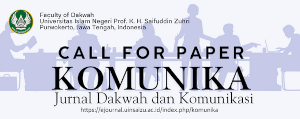Family Communication during the 2019 Corona Virus Disease (Covid-19) Pandemic
DOI:
https://doi.org/10.24090/komunika.v15i2.4589Keywords:
Family communication, interaction, Covid-19 pandemic, parents-children relationshipAbstract
Conversations among parents and children about the Corona Virus Disease 2019 (Covid-19) and how to prevent the transmission can reduce anxiety and a fear of children about the situation around them. Family communication refers to the verbal and non-verbal word that is happened between family members. Communication involves the ability to pay attention to others about what they think and feel. Communication does not only involve verbal words, but also listens to each other. The purpose of this article was to find out how parent-child communication during the Covid-19 pandemic. The method of this article used literature studies from books, scientific journals, and the internet websites. The results showed that healthy families communicated effectively well, while families with unhealthy relationships had poor communication. The effective communication in the family can be improved by family members through the quality of their relationships, namely frequent communication, communicating clearly and directly, being an active listener, communicating openly and honestly, thinking about people with whom to communicate, paying attention to non-verbal messages, communicating positively, and focus on family strengths. It is better if parents can increase their interaction with their children regarding Covid-19 messages during the pandemic, because it can make an impact on the relationship between parent-child.Downloads
Download data is not yet available.
References
Ashidiqie, M. L. I. I. (2020). Peran Keluarga Dalam Mencegah Corona Virus Disease 2019. Jurnal Sosial dan Budaya Syar’i, 7(10), 911–922. https://doi.org/10.15408/sjsbs.v7i8.15411
Bireda, A. D., & Pillay, J. (2016). Perceived parent–Child Communication and Well-Being Among Ethiopian Adolescents. International Journal of Adolescence and Youth, 23(1), 109–117. https://doi.org/10.1080/02673843.2017.1299016
Bowlby, J. (1988). A Secure Base: Parent-Child Attachment and Healthy Human Development. Basic Books. https://www.increaseproject.eu/images/DOWNLOADS/IO2/HU/CURR_M4-A13_Bowlby_(EN-only)_20170920_HU_final.pdf
Cangara, H. (2008). Pengantar Ilmu Komunikasi. PT Raja Grafindo Persada.
CDC. (2021). Families and COVID-19. Centers for Disease Control and Prevention (CDC).
Child Mind Institute (CMI). (2021). Family Resource Center. Childmind.Org. https://childmind.org/
Dai, L., & Wang, L. (2015). Review of Family Functioning. Open Journal of Social Sciences, 03(12), 134–141. https://doi.org/10.4236/jss.2015.312014
Dalton, L., Rapa, E., & Stein, A. (2020). Protecting The Psychological Health of Children Through Efective Communication About COVID-19. Lancet Child Adolescent Health, 4(5), 346–347. https://doi.org/10.1016/S2352-4642(20)30097-3
Department of Psychiatry, W. H. (2021). The Importance of Communication to Children. Department of Psychiatry Oxford University. https://www.psych.ox.ac.uk/research/covid_comms_support/families/the-importance-of-communication-to-children
Djamarah, S. B. (2014). Pola Asuh Orang Tua dan Komunikasi dalam Keluarga. PT Rineka Cipta.
Epstein, N. B., Ryan, C. E., Bishop, D. S., Miller, I. W., & Keitner, G. I. (2003). The McMaster Model View of Healthy Family Functioning. In F. Walsh (Ed.), Normal family processes: Growing diversity and complexity (pp. 581–607). The Guilford Press. https://doi.org/10.4324/9780203428436_chapter_21
Handel, G., & Whitchurch, G. G. (2017). The psychosocial interior of the family. In Routledge. Routledge.
Itzchakov, G., & Grau, J. (2020). High-Quality Listening in the age of COVID-19: A key to better dyadic communication for more effective organizations. Organizational Dynamic. https://doi.org/10.1016/j.orgdyn.2020.100820
Kaddi, S. M., Lestari, P., & Adrian, D. (2020). Komunikasi Keluarga dalam Pencegahan Coronavirus Disease 2019. Jurnal Ilmu Komunikasi, 18(1), 63–74. https://doi.org/10.31315/jik.v18i1.3701
Kamaruddin, S. A. (2012). Character Education and Students Social Behavior. Journal of Education and Learning (EduLearn), 6(4), 223. https://doi.org/10.11591/edulearn.v6i4.166
Karavasilis, L., Doyle, A. B., & Markiewicz, D. (2003). Associations Between Parenting Style and Attachment to Mother in Middle Childhood and Adolescence. International Journal of Behavioral Development, 27(2), 153–164. https://doi.org/10.1080/0165025024400015
Knapp, M. L., Hall, J. A., & Horgan, T. G. (2014). Nonverbal Communication in Human Interaction. Wadsworth Cengage Learning.
Maulana, H., & Gumelar, G. (2013). Psikologi Komunikasi dan Persuasi. Akademia Pratama.
Mitchell, F. (2020). Communicating With Children About COVID-19. The Lancet Infectious Disease, 20(9), 1023. https://doi.org/10.1016/S1473-3099(20)30626-5
Muhid, A., & Muslimin, M. (2020). Studi Literature: Peranan Komunikasi dalam Keluarga Dimasa Pandemi Covid-19. HIKMAH, 14(2), 185–198.
Noller, P., & Fitzpatrick, M. A. (1990). Marital Communication in The Eighties. Journal of Marriage and the Family, 52, 832–843. https://doi.org/10.2307/353305
Peterson, R., & Green, S. (2009). Families First: Keys to Successful Family Functioning Communication. Virginia Cooperative Extension (VCE). http://hdl.handle.net/10919/48300
Pieh, C., O´Rourke, T., Budimir, S., & Probst, T. (2020). Relationship Quality and Mental Health During COVID-19 Lockdown. PLOS ONE, 16(9). https://doi.org/10.1371/journal.pone.0238906
Rakhmat, J. (2012). Psikologi Komunikasi. Remaja Rosda Karya.
Runcan, P. L., Constantineanu, C., Ielics, B., & Popa, D. (2012). The Role of Communication in The Parent-Child Interaction. Procedia - Social and Behavioral Sciences, 46, 904 – 908. https://doi.org/10.1016/j.sbspro.2012.05.221
Segrin, C., & Flora, J. (2019). Family Communication. Routledge.
Soma, G. J. (2020). Communicating to children About The COVID-19 Pandemic. South Sudan Medical, 13(2), 60–63. http://www.southsudanmedicaljournal.com/archive/may-2020/communicating-to-children-about-the-covid-19-pandemic.html
Suciati. (2015). Komunikasi Interpersonal: Sebuah Tinjauan Psikologis dan Perspektif Islam. Buku Litera Mata Padi Persindo.
Tang, S., Xiang, M., Cheung, T., & Xiang, Y.-T. (2021). Mental health and its correlates among children and adolescents during COVID-19 school closure: The importance of parent-child discussion. Journal of Affective Disorders, 279, 353–360. https://doi.org/10.1016/j.jad.2020.10.016
Turner, L., & West, R. (2012). Perspective on Family Communication. McGrawHill.
UNICEF. (2020). Recommendations to families on how to combine working from home with caring for young children. https://www.unicef.org/lac/media/11251/file/Teleworking-and-caring-for-children.pdf
West, R., & Turner, L. H. (2008). Pengantar Teori Komunikasi. Analisis dan Aplikasi. Salemba.
Whittle, S., Bray, K., Lin, S., & Schwartz, O. (2020). Parenting and child and adolescent mental health during the COVID-19 pandemic. https://doi.org/10.31234/osf.io/ag2r7
WHO. (2020a). #HealthyAtHome - Healthy parenting. World Health Organization. https://www.who.int/campaigns/connecting-the-world-to-combat-coronavirus/healthyathome/healthyathome---healthy-parenting
WHO. (2020b). WHO Director-General’s opening remarks at the media briefing on COVID-19 - 11 March 2020. World Health Organization. https://www.who.int/director-general/speeches/detail/who-director-general-s-opening-remarks-at-the-media-briefing-on-covid-19---11-march-2020
Wood, J. T. (2014). Komunikasi Interpersonal. Salemba Humanika.
Wu, Q., & Xu, Y. (2020). Parenting Stress and Risk of Child Maltreatment During The COVID-19 Pandemic: A family Stress Theory Informed Perspective. Developmental Child Welfare, 2(3), 180–196. https://doi.org/10.1177/2516103220967937
Bireda, A. D., & Pillay, J. (2016). Perceived parent–Child Communication and Well-Being Among Ethiopian Adolescents. International Journal of Adolescence and Youth, 23(1), 109–117. https://doi.org/10.1080/02673843.2017.1299016
Bowlby, J. (1988). A Secure Base: Parent-Child Attachment and Healthy Human Development. Basic Books. https://www.increaseproject.eu/images/DOWNLOADS/IO2/HU/CURR_M4-A13_Bowlby_(EN-only)_20170920_HU_final.pdf
Cangara, H. (2008). Pengantar Ilmu Komunikasi. PT Raja Grafindo Persada.
CDC. (2021). Families and COVID-19. Centers for Disease Control and Prevention (CDC).
Child Mind Institute (CMI). (2021). Family Resource Center. Childmind.Org. https://childmind.org/
Dai, L., & Wang, L. (2015). Review of Family Functioning. Open Journal of Social Sciences, 03(12), 134–141. https://doi.org/10.4236/jss.2015.312014
Dalton, L., Rapa, E., & Stein, A. (2020). Protecting The Psychological Health of Children Through Efective Communication About COVID-19. Lancet Child Adolescent Health, 4(5), 346–347. https://doi.org/10.1016/S2352-4642(20)30097-3
Department of Psychiatry, W. H. (2021). The Importance of Communication to Children. Department of Psychiatry Oxford University. https://www.psych.ox.ac.uk/research/covid_comms_support/families/the-importance-of-communication-to-children
Djamarah, S. B. (2014). Pola Asuh Orang Tua dan Komunikasi dalam Keluarga. PT Rineka Cipta.
Epstein, N. B., Ryan, C. E., Bishop, D. S., Miller, I. W., & Keitner, G. I. (2003). The McMaster Model View of Healthy Family Functioning. In F. Walsh (Ed.), Normal family processes: Growing diversity and complexity (pp. 581–607). The Guilford Press. https://doi.org/10.4324/9780203428436_chapter_21
Handel, G., & Whitchurch, G. G. (2017). The psychosocial interior of the family. In Routledge. Routledge.
Itzchakov, G., & Grau, J. (2020). High-Quality Listening in the age of COVID-19: A key to better dyadic communication for more effective organizations. Organizational Dynamic. https://doi.org/10.1016/j.orgdyn.2020.100820
Kaddi, S. M., Lestari, P., & Adrian, D. (2020). Komunikasi Keluarga dalam Pencegahan Coronavirus Disease 2019. Jurnal Ilmu Komunikasi, 18(1), 63–74. https://doi.org/10.31315/jik.v18i1.3701
Kamaruddin, S. A. (2012). Character Education and Students Social Behavior. Journal of Education and Learning (EduLearn), 6(4), 223. https://doi.org/10.11591/edulearn.v6i4.166
Karavasilis, L., Doyle, A. B., & Markiewicz, D. (2003). Associations Between Parenting Style and Attachment to Mother in Middle Childhood and Adolescence. International Journal of Behavioral Development, 27(2), 153–164. https://doi.org/10.1080/0165025024400015
Knapp, M. L., Hall, J. A., & Horgan, T. G. (2014). Nonverbal Communication in Human Interaction. Wadsworth Cengage Learning.
Maulana, H., & Gumelar, G. (2013). Psikologi Komunikasi dan Persuasi. Akademia Pratama.
Mitchell, F. (2020). Communicating With Children About COVID-19. The Lancet Infectious Disease, 20(9), 1023. https://doi.org/10.1016/S1473-3099(20)30626-5
Muhid, A., & Muslimin, M. (2020). Studi Literature: Peranan Komunikasi dalam Keluarga Dimasa Pandemi Covid-19. HIKMAH, 14(2), 185–198.
Noller, P., & Fitzpatrick, M. A. (1990). Marital Communication in The Eighties. Journal of Marriage and the Family, 52, 832–843. https://doi.org/10.2307/353305
Peterson, R., & Green, S. (2009). Families First: Keys to Successful Family Functioning Communication. Virginia Cooperative Extension (VCE). http://hdl.handle.net/10919/48300
Pieh, C., O´Rourke, T., Budimir, S., & Probst, T. (2020). Relationship Quality and Mental Health During COVID-19 Lockdown. PLOS ONE, 16(9). https://doi.org/10.1371/journal.pone.0238906
Rakhmat, J. (2012). Psikologi Komunikasi. Remaja Rosda Karya.
Runcan, P. L., Constantineanu, C., Ielics, B., & Popa, D. (2012). The Role of Communication in The Parent-Child Interaction. Procedia - Social and Behavioral Sciences, 46, 904 – 908. https://doi.org/10.1016/j.sbspro.2012.05.221
Segrin, C., & Flora, J. (2019). Family Communication. Routledge.
Soma, G. J. (2020). Communicating to children About The COVID-19 Pandemic. South Sudan Medical, 13(2), 60–63. http://www.southsudanmedicaljournal.com/archive/may-2020/communicating-to-children-about-the-covid-19-pandemic.html
Suciati. (2015). Komunikasi Interpersonal: Sebuah Tinjauan Psikologis dan Perspektif Islam. Buku Litera Mata Padi Persindo.
Tang, S., Xiang, M., Cheung, T., & Xiang, Y.-T. (2021). Mental health and its correlates among children and adolescents during COVID-19 school closure: The importance of parent-child discussion. Journal of Affective Disorders, 279, 353–360. https://doi.org/10.1016/j.jad.2020.10.016
Turner, L., & West, R. (2012). Perspective on Family Communication. McGrawHill.
UNICEF. (2020). Recommendations to families on how to combine working from home with caring for young children. https://www.unicef.org/lac/media/11251/file/Teleworking-and-caring-for-children.pdf
West, R., & Turner, L. H. (2008). Pengantar Teori Komunikasi. Analisis dan Aplikasi. Salemba.
Whittle, S., Bray, K., Lin, S., & Schwartz, O. (2020). Parenting and child and adolescent mental health during the COVID-19 pandemic. https://doi.org/10.31234/osf.io/ag2r7
WHO. (2020a). #HealthyAtHome - Healthy parenting. World Health Organization. https://www.who.int/campaigns/connecting-the-world-to-combat-coronavirus/healthyathome/healthyathome---healthy-parenting
WHO. (2020b). WHO Director-General’s opening remarks at the media briefing on COVID-19 - 11 March 2020. World Health Organization. https://www.who.int/director-general/speeches/detail/who-director-general-s-opening-remarks-at-the-media-briefing-on-covid-19---11-march-2020
Wood, J. T. (2014). Komunikasi Interpersonal. Salemba Humanika.
Wu, Q., & Xu, Y. (2020). Parenting Stress and Risk of Child Maltreatment During The COVID-19 Pandemic: A family Stress Theory Informed Perspective. Developmental Child Welfare, 2(3), 180–196. https://doi.org/10.1177/2516103220967937

Downloads
Published
2021-12-29
Issue
Section
Articles
License
Authors who publish with this journal agree to the following terms:
- Authors retain copyright and grant the journal right of first publication with the work simultaneously licensed under a Creative Commons Attribution-ShareAlike 4.0 International License that allows others to share the work with an acknowledgement of the work's authorship and initial publication in this journal.
- Authors are able to enter into separate, additional contractual arrangements for the non-exclusive distribution of the journal's published version of the work (e.g., post it to an institutional repository or publish it in a book), with an acknowledgement of its initial publication in this journal.
- Authors are permitted and encouraged to post their work online (e.g., in institutional repositories or on their website) prior to and during the submission process, as it can lead to productive exchanges, as well as earlier and greater citation of published work (See The Effect of Open Access).




























